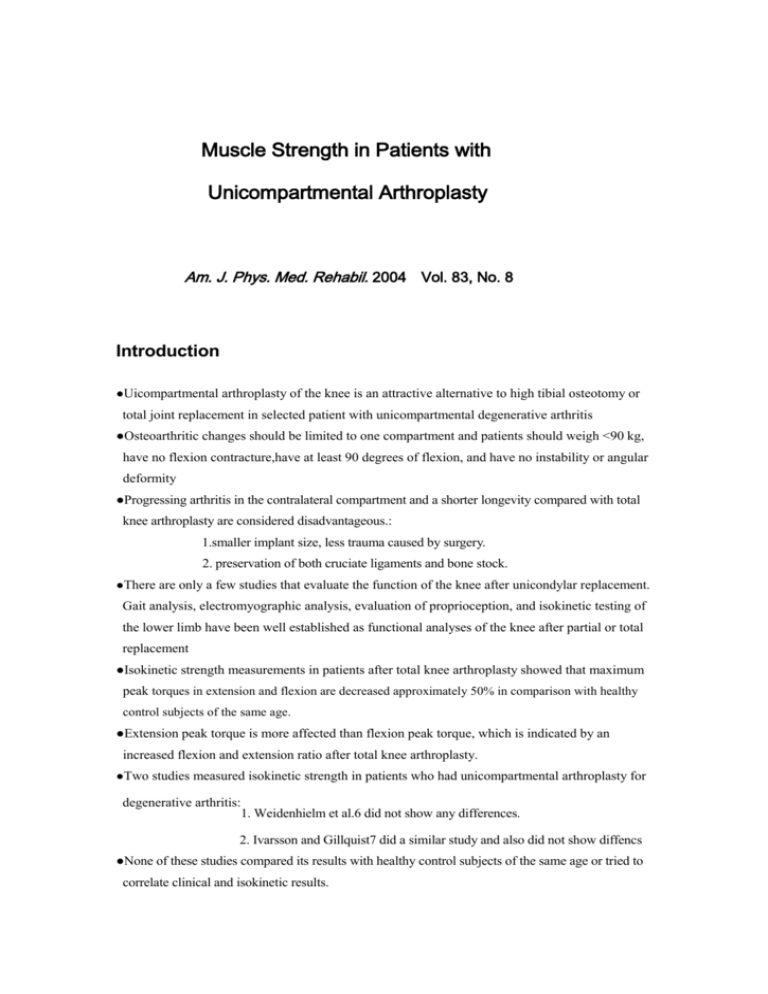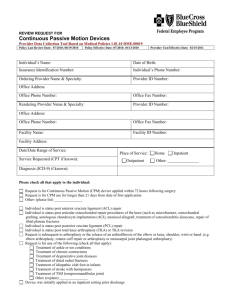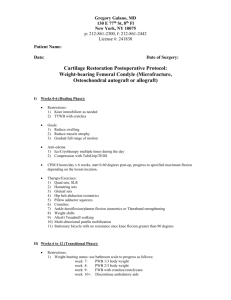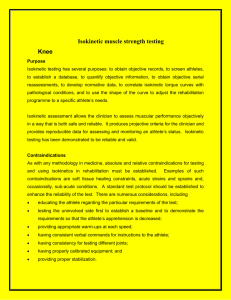Muscle Strength in Patients with Unicompartmental Arthroplasty
advertisement

Muscle Strength in Patients with Unicompartmental Arthroplasty Am. J. Phys. Med. Rehabil. 2004 Vol. 83, No. 8 Introduction ●Uicompartmental arthroplasty of the knee is an attractive alternative to high tibial osteotomy or total joint replacement in selected patient with unicompartmental degenerative arthritis ●Osteoarthritic changes should be limited to one compartment and patients should weigh <90 kg, have no flexion contracture,have at least 90 degrees of flexion, and have no instability or angular deformity ●Progressing arthritis in the contralateral compartment and a shorter longevity compared with total knee arthroplasty are considered disadvantageous.: 1.smaller implant size, less trauma caused by surgery. 2. preservation of both cruciate ligaments and bone stock. ●There are only a few studies that evaluate the function of the knee after unicondylar replacement. Gait analysis, electromyographic analysis, evaluation of proprioception, and isokinetic testing of the lower limb have been well established as functional analyses of the knee after partial or total replacement ●Isokinetic strength measurements in patients after total knee arthroplasty showed that maximum peak torques in extension and flexion are decreased approximately 50% in comparison with healthy control subjects of the same age. ●Extension peak torque is more affected than flexion peak torque, which is indicated by an increased flexion and extension ratio after total knee arthroplasty. ●Two studies measured isokinetic strength in patients who had unicompartmental arthroplasty for degenerative arthritis: 1. Weidenhielm et al.6 did not show any differences. 2. Ivarsson and Gillquist7 did a similar study and also did not show diffencs ●None of these studies compared its results with healthy control subjects of the same age or tried to correlate clinical and isokinetic results. ●The aim of the current study was to compare the isokinetic strength in flexion and extension of the knee inpatients with unicondylar sledge prostheses and healthy control subjects of the same age and to attempt to correlate the isokinetic results with clinical score results. MATERIALS AND METHOD ● A total of 17 patients, 16 women and one man, with unicondylar sledge prostheses (five Endo, Link, Hamburg, Germany; 12 Search, Aesculap,Tuttlingen, Germany; 12 were medial and five were lateral) were examined at an average follow-up of21.5 + 8.7 mos (range, 9–36mos) ● Seven patients had surgery on the left knee and ten patients had surgery on the right knee. ● All patients participated in the hospital’s former standard rehabilitation program:1. mainly was aimed at range of motion, 2. proprioceptive abilities. ● program consisted of 5 wks of inpatient rehabilitation (hospital and rehabilitation facility) and 12–16 additional weeks of outpatient rehabilitation (2–3 times/wk). ● No patient received specific strengthening exercises of lower limb muscles. The patients included did not have radiologic signs of loosening or malalignment at follow-up. ● control group of 11 healthy subjects without a history of knee problems and a normal examination was used for comparison. ● Clinical examination was done using the Hospital for Special Surgery score, the Knee Society score, and the patellar score. All three are common clinical scores that assess objective measures. ● Isokinetic evaluation of knee extensor and flexor muscles was doneusing a Cybex 6000 dynamometer. ● After sufficient warm-up, measurements were recorded at angular velocities of 60 and 180 degrees/sec, using the computerbased data acquisition system. ● Statistical analysis was done with a commercial program (Stat View,Version 5.0, SAS Institute, Heidelberg,Germany). Mann-Whitney U test was used to compare control and patient groups Wilcoxon’s signed-rank test was done for intraindividual comparison of both legs in each group RESULTS ●The average age of the patients was 62.5 +8.3 yrs (range, 50 –77 yrs). The average height of the patients was 167+7.6 cm, and the average weight was 84.6+20.3 kg. ● The control group consisted of six men and five women with an average age of 69.1 + 5.5 yrs (range, 60 –75 yrs). The average height of the control subjects was 168.5 + 8.8 cm (women, 165.6+ 4.7 cm;men, 171.2+7.2 cm), and their average weight was 72.2+10.6 kg (women, 67.4 + 11.8 kg; men, 76.2+ 8.5 kg). ●There were no significant differences in demographics between sexes in the control group or between patient and control groups (P > 0.05). ●Statistical analysis of the clinical results revealed neither a difference between the types of prostheses. ●Hospital for Special Surgery score, P = 0.355; Knee Society score, P = 0.834; patellar score, P =0.53) nor a difference between implantation sites (medial vs. lateral; Hospital for Special Surgery score, P = 0.425; Knee Society score, P =0.371; patellar score, P =0.33). Therefore, the following results comprise the localizationsand prostheses. ●The control group scored nearly maximum results in clinical examination. They achieved an average Hospital for Special Surgery score of 93.1 + 10.3 of 100 points and a Knee Society score of 192.3+14.6 of 200 points. The patellar score averaged 29.6+ 1.5 of 30 points, and the visual analog scale for pain averaged 9.9 +0.3 of 10 points. The patients’ clinical results were significantly lower (P <0.05) than the clinical results of the control subjects. ●Table 1 shows the patients’ results on the Short Form 36 Health Questionnaire. Comparing patients and control subjects, only the following items differed significantly: physical functioning (P = 0.003), role limitation due to physical problems (P = 0.0117), and bodily pain (P = 0.0293) ●Peak flexion torques at 60 and 180 degrees/sec in patients were significantly lower compared with the control subjects (Table 2).The patients achieved only approximately 70% of normal flexion strength. In maximum isokinetic strength in extension at 60 and 180 degrees/sec, the patients achieved only approximately 70% of normal strength. ●The average flexion and extension ratios of maximum peak torque in patients did not differ from those in control subjects (Table 2). ●Correlation analysis of isokinetic data and clinical score results or isokinetic data and eight different Short Form 36 items, respectively, revealed no statistically significant correlation coefficient. DISCUSSION ●To the current authors’ knowledge, only two reports can be found in the literature that address the muscle strength ●.Ivarsson and Gillquist were able to prove a faster recovery of muscle strength in the postoperative course in patients who had unicompartmental knee arthroplasty compared with patients who had high tibial osteotomy. ●The results 6 mos postoperatively were better in the patients who were treated with unicompartmental arthroplasty than they were 12 mos postoperatively in the patients treated with high tibial osteotomy. ●The current authors showed that after unicompartmental knee arthroplasty, patients had a clear deficit of peak torque of approximately 30% in extension and flexion at 60 and 180 degrees/sec compared with the control group. ●Isokinetic strength measurements in patients after total knee replacement showed that maximum peak torques in extension and flexion are decreased approximately 50% in comparison with healthy control subjects of the same age. ●The persisting extensor weakness was thought to be related to anterior cruciate ligament resection because patients with an anterior cruciate ligament rupture have similar quadriceps deficits. ●The present study has two methodological limitations: 1. retrospective study design 2. the different female-to-male ratio in the patient and control group. ●Unicompartmental arthroplasty seems to fail to restore age. This is most probably attributable to the preoperative phase of reduced activity because patients with osteoarthritis have been reported to already have decreased muscle strength. ●The underlying reasons are probably the smaller operative approach that does not injure the quadriceps muscle and the preservation of the anterior cruciate ligament that prevents quadriceps.







